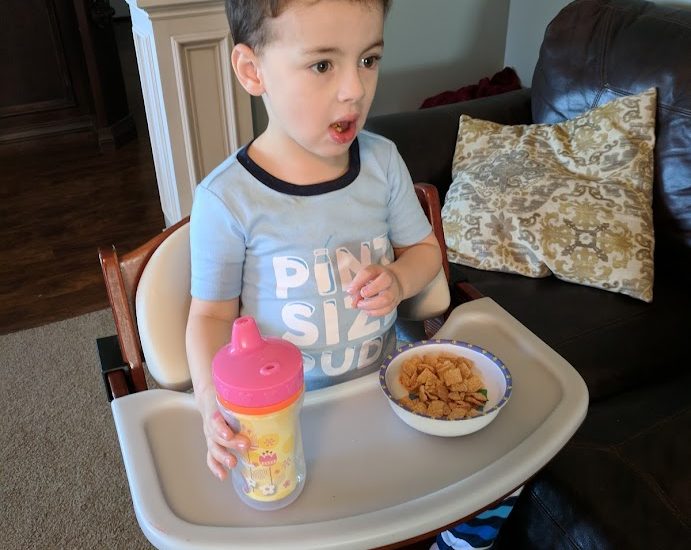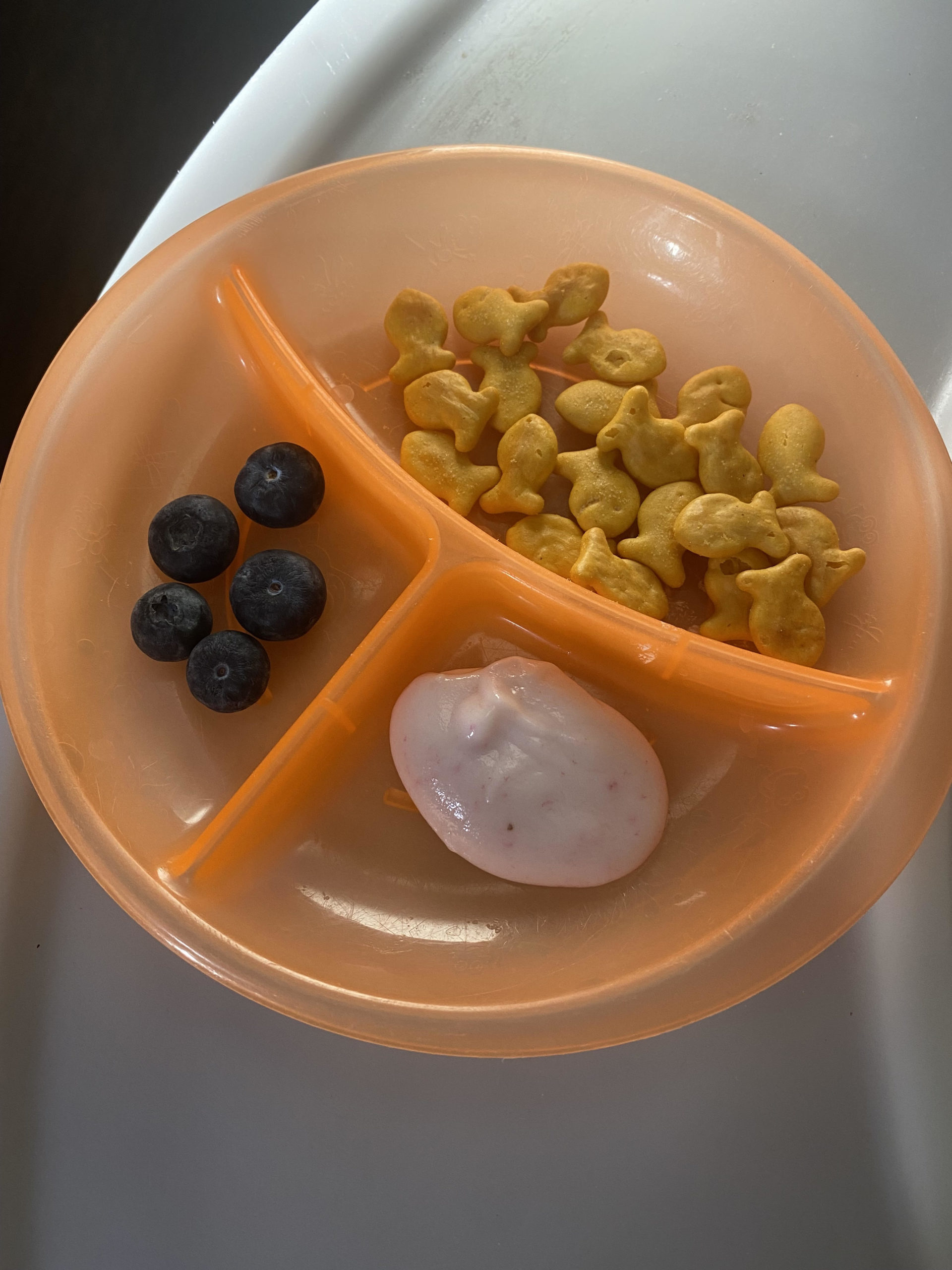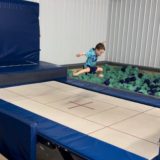Feeding Therapy

I always vowed as a pre-parent that I would not make separate meals for my kids. One of those things that I look back now and just shake my head about my imaginary, perfect parent self that I pictured being before I became an actual parent. I would say that we started the food journey off like any other parents: From breastfeeding to baby food to breaking up some of our own food and sharing it, everything was going runny smooth in the beginning. But somewhere along the way (around the time of toddlerhood), my child became EXTREMELY picky, not just to the way things tasted but to the way they looked. I had hoped it was just a phase, but as time went on things just got worse. He started developing a lot of sensory sensitivities around food, and I felt like the list of what he was willing to eat became smaller and smaller. I kid you not when I say there was a point in his life that he would only willingly eat lays potato chips, goldfish crackers, and one type of granola bar. I knew that I had to do something. This wasn’t a healthy or sustainable diet for him. I tried what I could at home, all the old school methods that people push about how to handle picky eaters. We tried nice ways like just offering more varieties of foods and letting him see us eat them. When that didn’t work, we moved onto the “if you don’t eat what I give, you then you won’t eat” method. It went horribly bad. I fully believe that if I would have continued that road we would have ended up in the hospital because his aversion to trying new foods is so great that he just didn’t eat for two days. I couldn’t hold out longer than that. It was painful and I needed a new plan. I reached out to my county board of DD rep for help. They suggested feeding therapy.
I didn’t even know that this was a thing, but I didn’t hesitate to get the ball rolling on it as soon as I found out. At the time when we were looking into feeding therapy (Early 2017), our regular children’s hospital that we were used to working with did not have the program. The only provider that I could find somewhat near us was Nationwide Children’s Hospital in Columbus.
The Assessment
We scheduled an appointment and went in for his initial assessment. Although Damion was required to come to the assessment, it was really nothing more than just me answering questions about the difficulties I was having with him when it came to feeding. They did note that he didn’t seem to have any physical disabilities that would make feeding a problem, it was purely behavioral. Based on my responses they all agreed that it would be good for him to start the feeding therapy program at their feeding clinic in Westerville, a suburb of Columbus.
The Commitment
The program is MUCH more time intensive than other therapy programs that we are used to. For the basic set up of the program, they give you a therapy time that corresponds with a normal feeding time like breakfast or lunch. You try to not let the child eat too long before your scheduled appointment so they will be hungry when it is time for the session. Our time was scheduled for first thing in the morning, so that was not too hard for us to do. Whereas most therapies are once a week for a 30-minute session, the feeding therapy program was still a 30-minute session, but it was 3 days a week, for 8 weeks straight. We were scheduled to go Monday, Tuesday, and Thursday mornings. After your initial 8-week stint, then you will have follow-up check in appointment at various intervals to check in on progress at home.
The clinic was an hour drive from my house. Damion was in a morning preschool at this time so we had to limit his days of school attendance to once per week. I was still working a full-time job then as well, luckily my job was very accommodating and I was able to take him and adjusted my hours accordingly. This was quite the commitment for us, but it was important, so we powered through and added the rigorous program to our already busy schedules.

The Basics of the program
The child is put in comfortable high chair with a foot support. This is a specific type of chair that would work even with larger children. The program is set up so that you have a three sectioned plate of food. The child is to take one bite from each section of food, working around the plate in the same pattern each time. If the bites were taken, he was given the reward. For Damion at this time, his reward was getting to watch his favorite sign language song video on an iPad. In the first session only, preferred foods are offered to start off setting with a positive experience. As the program continued, some of the sections of food would become more difficult. You would always keep one section with preferred food on the plate, but there would also be bites required of the non-preferred foods. If bites were not taken, the reward was removed.

Keekaroo High Chair
The Good, the Bad, and the Ugly with the Program
This program is not only a program for your child, it is a big teaching tool for you. I learned a great number of things including: Basic positive reinforcement techniques, not giving attention to bad behaviors that came with pushing non-preferred foods, how to set up a plate in a way that was not too overwhelming for my child, and that kids tend to eat better if they are not allowed to snack and sit down at specific meal times. It is very informative. Damion made good progress with the 8-week program.
The distance to get the clinic was not ideal, but I am happy to note that more places seem to be picking up programs like these so hopefully for those looking now they are not too hard to find. Food was brought from home for the session and with it being such a long drive hot food was not really an option to try. I felt this limited our progress a bit as well. It would have been nice to have been able to push more hot foods as well since he had issues with many.
Our biggest downside to this program, as is with a lot of things in our life with Damion was the generalization of the program outside of the clinic. I did my best to model the set up at the clinic. I purchased the same pretty pricey high chair (shown above) that they had used. I got the plates with 3 dividers (pro tip: get the suction ones so they can’t throw the plate), and I set our video reward to only be used at the time of feeding therapy. But even with all that set up in place, the transition to doing this at home was hard. He had some hard times at the clinic with the pushes to non-preferred foods, but it was nothing like the meltdowns that he could get worked up to the in-home setting with me. Not a huge difference to what we have seen in other areas of life, what he is willing to do for therapists or teachers or someone specific is not always what he is willing to do for me. But we tried hard and kept powering through.
The Continuation
Over time our normal life came back into focus. Feeding improved after going to the clinic. It wasn’t the huge life changing improvement that I had hoped for, like many other things in our life, progress comes more in baby steps. Some of the feeding therapy techniques are still used by me on a daily basis, but not quite the level of what we did in the beginning. We work on our “big boy bites” when we try new or not preferred items. Some days the push back is bigger than others. Some days my willingness to push it is better than others. I’m glad we went through the program. I learned a lot. I have come to the realization that Damion will likely always be a pickier eater, that I will continue to have to push him and prompt him to try more and little by little we are getting there. I am just happy that even though preferred choices are still somewhat limited, it is to the point where he at least has a fairly well-rounded diet. We aren’t living off chips and granola bars anymore! Although I always wish for more progress faster, I am certain he would not be as far along as his is without the program.




